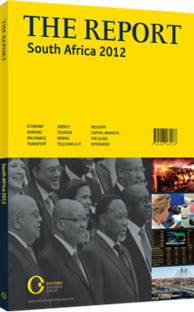OBG talks to Godfrey Gomwe, Executive Director, Anglo American South Africa; Nick Holland, CEO, Gold Fields; and Andile Sangqu, Executive Director, Xstrata South Africa

Interview: Godfrey Gomwe, Nick Holland, Andile Sangqu
How are mining companies in South Africa managing and offsetting input-cost pressures?
GODFREY GOMWE: In the face of significant cost pressures towards labour, fuel and power, mining companies are applying cost-mitigating efforts through asset and procurement optimisation and moving towards greater capital intensity. To remain competitive, South Africa’s mining sector is dependent on an efficient and cost-effective logistics and power sector. Both Transnet and Eskom are vitally important service providers, as future investments are less likely to happen if infrastructure challenges are not resolved.
We need an efficient logistics infrastructure to move products to markets in a timely and cost-effective manner and recognise that Transnet’s current five-year investment programme of R93.4bn ($1.14bn) to improve rail, ports and pipelines is unprecedented. The adoption of a long-term framework to ensure that rail capacity matches demand is a positive step, and we believe that all stakeholders in the mining industry should come together to develop a long-term freight strategy.
Similarly, an inability to provide assurances over power supply will hamper economic growth and prevent forward planning in all heavy industries.
We continue to work with Eskom for solutions, with public-private partnerships having a definite role to play in this. We have established a joint working group with Eskom and are looking to establish an energy efficiency partnership, and we are also looking into a number of co-generation and independent power producer (IPP) initiatives.
NICK HOLLAND: Strict cost control is essential as South African mining companies were last year confronted with a 27% rise in Eskom electricity tariffs, a 10% wage increase and sharp jumps in the cost of steel, timber and other commodity input costs. We have taken a holistic view of our operational and labour requirements and implemented significant efficiencies in our procurement and operational processes. No retrenchments were effected but we did not replace staff that left, offered voluntary retrenchment packages to employees and replaced nonessential contract services with in-house staff.
Surging electricity costs have a significant impact on our cost structure and our focus has been on reducing energy demand. From our 2007 baseline to the end of 2011 we have already achieved a 17% reduction. The emphasis on reducing electricity consumption will remain, despite the welcome decision by South Africa’s energy regulator to reduce average tariff increases from 26% to 16%. We believe that Eskom must remain the core supplier of electricity, with new suppliers gradually introduced into the grid. The biggest contribution the mining industry can make to the security of supply is through electricity efficiency and savings initiatives. Like many others we are looking at alternative energy supplies at our operations, but these remain at the fringe of our strategy for now; the key driver must be electricity consumption reduction which has the added SANGQU: South Africa is competing for investments with the rest of the world, and in addition to consistent and business-friendly policies, costs very much come into play. There is a need to introduce new energy capacity to resolve supply problems and Mining companies have worked successfully with parastatals in other jurisdictions, contributing not only technical skills, but also their own capital to fund power and rail projects. This helps to reduce the exposure that governments have to these projects, freeing up government funding to address social issues that are more pressing than infrastructure.
Another operational cost we deal with is related to health and safety. Mining is a dangerous operation, and issues of safety require the concerted effort of all parties. We remain committed to these matters as an industry. We need to ensure that the right balance is created by maintaining world-class safety standards while ensuring that the mining companies can work productively and efficiently.
While not a direct input cost, another concern involves a set of additional taxes that is being proposed. Due to the mobility of capital, investors will evaluate the returns generated against what can be generated in other geographies. The focus should be on growing the size of the mining industry by enhancing productivity and making it globally competitive. This will create jobs, increase the industry’s contribution to central funds and help absorb the effect of social pressures directed at the industry.
What impact has the protracted nationalisation debate had on investment in the sector?
HOLLAND: We never believed that nationalisation was a policy option for South Africa and neither did the South African government. Most international investors knew that and I do not think the impact on investor confidence was significant.
However, we are facing resource nationalism to a varying degree at all our operating locations, not just in South Africa and this is something we have to consider as we are looking at growth investment. The South African government is contemplating other tax-based measures to extract more funds from the sector. Any further government impositions – for example in the form of a resource-rent tax – would do much to undermine the mining industry and its capacity to generate employment. The ability of any mining company to make sustained contributions to local communities and host countries is almost completely dependent on its profitability. In the absence of further increases in commodity prices, higher taxes and more stringent regulations will limit the ability of the sector to make such contributions.
ANDILE SANGQU: Broadly speaking, the nationalisation debate is about the intention of the state to increase its role in the industry. In other regions, we have seen the state acting as a player, not just a regulator. We do not oppose the government ownership and operation of mines, as long as it competes transparently and on a level playing field. To be fair, government companies must be subject to the same rules, environmental assessment plans and set of licences as the private sector.
We now know that the government is thankfully not going to be nationalising mines, but are still working to fully understand how they will be implementing new resource taxes.
At the moment, margins are being squeezed and we are facing a number of cost pressures. At some point, there is only so much we can absorb, and if other jurisdictions do not require as much taxes, making it more competitive to operate there, these are decisions we will have to evaluate.
GOMWE: While some oil-producing nations have had some success in doing so, nationalisation of the minerals sector has failed in most countries that have tried it. And we do not know of any directly comparable examples to South Africa where nationalisation has worked. South Africa has benefitted from a strong, predictable and transparent regulatory regime, and a continued debate on nationalisation would have been catastrophic for the industry.
Nationalisation would offer very limited benefits for the country, with internal studies showing that approximately 89% of mining value creation is already captured domestically. As a result of multiple competing priorities and constraints on available capital, the South African government has a history of under-investing in the assets it owns, and its state-owned mining companies have had poor track records in recent years. Federal takeover of the mines at fair value compensation could lead to lower productivity and would place a significant strain on public finances. Given the large role of mining in the South African economy, this carries great social and economic risk for the country as a whole.
How is the mining industry faring at present in terms of transformation, environmental responsibility and community engagement?
SANGQU: Transformation is an important topic, given the need to redress the imbalances of the past and to ensure future political stability for the country as a whole. However, it must be done genuinely and sustainably. If irrationally enforced, it leads to fronting and can actually harm the industry.
Procurement legislation should be a catalyst for cost competitiveness, high quality standards and good safety standards. I am in full support of employment equity as it allows people who were previously on the periphery to be absorbed into the system and achieve their aspirations. It also helps create a diversity of leadership and decision making.
Something that should be further accommodated and encouraged on the ownership side is incorporating employee or community ownership schemes. Having these two stakeholder groups share in profits generates a greater sense of commitment and helps reduce social risk. It can also help to ensure that when resources are depleted the employees and community still have windfalls to fall back on.
We are fully committed to our environmental obligations, but we find it challenging that the administration and regulation sits in various government departments and is not synchronised.
With respect to community engagement, social initiatives are tied to the size of our profits. In good times, we can allocate significant sums to them, while in the leaner years the amount is smaller even though the need is the same.
GOMWE: Like many other major mining companies, we are committed to mining in a sustainable way that adds value to the communities around our projects. We believe that as an industry we can work together more closely with our peers and with government to address critical issues, such as water supply sustainability. I believe that the best way to address the transformational potential of the mining industry is to continue to enable it to contribute towards economic growth and productivity. If we expand the economy and improve productivity we can create more jobs and increase wages. That means you need new enterprises and consistent investments in commercial activity through skills, technological innovation, and capital development.
HOLLAND: We believe that the mining charter is a sound guideline that has framed the transformation of the industry. If mining companies adhere not just to the numerical targets of the charter, but also to its underlying spirit, then there will be continued progress in transforming the industry.
We have made all of our employees shareholders in the company as part of our black economic empowerment programmes and we have also ensured that communities benefit from two trusts that channel funds into educational and community projects. This, combined with our work on other aspects of the charter initiatives, will result in further meaningful transformation of the industry. In fact, it is a business imperative for companies to transform and adapt to new standards.
There can be no doubt that the mining industry has been guilty of many transgressions in the past. This applies in terms of environmental responsibility, investment in neighbouring communities and labour sources, and even in the treatment of its own employees. However, most of the top mining companies have transformed significantly over the past two decades and are leading proponents of sustainable development. Companies’ work in areas such as combating HIV/AIDS, carbon emission mitigation and environmental rehabilitation is on the leading edge of corporate sustainable development at a global level. Criticism of the mining industry often overlooks this fact and that mining, done responsibly, can have a positive socio-economic impact on communities, government and other stakeholders.
You have reached the limit of premium articles you can view for free.
Choose from the options below to purchase print or digital editions of our Reports. You can also purchase a website subscription giving you unlimited access to all of our Reports online for 12 months.
If you have already purchased this Report or have a website subscription, please login to continue.

